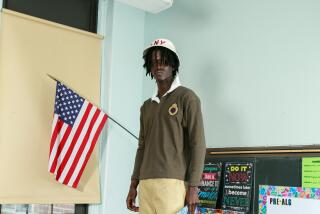Cherokee Dons Brand-New Look : Apparel Company Will Test Back-to-Basics Line in Summer
- Share via
Since Cherokee Inc. emerged from its bankruptcy reorganization last May, nothing has been quite the same at the clothing and shoe company.
Guess? Inc. co-founder Georges Marciano and Saudi businessman Abdullah Taha Bakhsh have scooped up Cherokee’s stock. Together they own about 32%. Cherokee Apparel, the company’s main division, is now being run by a team of former Lee Apparel executives. Even Cherokee’s 20-year-old Indian head logo is history.
But will any of this turn the company’s fortunes around?
That will be answered this summer when Cherokee, based in Sunland, tests its revived back-to-basics fashion strategy under Joe Elles, a 12-year veteran of Lee Apparel.
Since becoming president of Cherokee Apparel in September, Elles has discarded Cherokee’s scattered array of clothing, including all of its dressy outfits and combination wear. Cherokee’s new fall lineup, which will be shipped this month, instead focuses on a much narrower line of jeans, casual pants and shirts for women.
“Basically, they didn’t stand for anything and they had everything,” Elles said. Before joining Cherokee, Elles, 39, was Lee’s vice president and general manager, the No. 2 post at the $1-billion jeans company.
Elles, known as a high-charging salesman, has used his industry connections to win back business for Cherokee from retailers such as Carter Hawley Hale Stores, operator of the Broadway chain. Carter Hawley and other big retailers had dropped Cherokee in recent years because of the company’s financial troubles and what they described as its lack of focus.
Carter Hawley says it is now impressed with Cherokee’s new system to replenish inventory of key pants on a weekly basis. Previously, Elles said, it took Cherokee as long as 12 weeks to restock store racks.
Broadway is just the sort of moderately priced department store in which Elles wants to position Cherokee. So he is curtailing business at discount stores and doing less with retailers such as Mervyn’s, which at one time accounted for 25% of Cherokee Apparel’s sales.
Elles is also cutting Cherokee’s retail pants prices by $4 to $8 a pair. Elles dumped the Indian head logo because, he said, it added no value to the product, replacing it with more informative labels stressing fit and fabric. And he plans to launch a $7-million advertising campaign later this year, double last year’s ad budget.
“If we can get (customers) to try it on,” Elles said, “we think they’ll buy it because of the fit.”
But that’s a big if. Department stores are entrenched with a few big brands along with a clutter of private labels and also-rans. In women’s jeans, for example, Elles is up against Lee, which dominates with almost 20% of that market, compared to 1% for Cherokee. In the casual pants market for women, J. C. Penney’s private label is No. 1, followed by Levi’s popular Dockers brand and then Cherokee. Cherokee Apparel also sells tops, but three-quarters of its business is in pants and shorts.
“At this time, the stores in America could get rid of half of the brands, and there’d still be enough to cover everybody,” said Harry Bernard, a partner at Colton Bernard, an apparel consultant in San Francisco.
Bernard says Cherokee has a well-recognized name and has built a good-size volume. He adds that Elles “is a hell of a salesman.” But Cherokee has much to overcome, Bernard said. “The image of Cherokee was that it was everywhere. It was not a confined product, and it didn’t have a specific niche.”
“We relied on the same thing for too long and the consumer rejected it,” said Cary Cooper, who has been Cherokee’s chief financial officer since 1988 and is one of the few executives who survived the shakeout at Cherokee.
Cherokee Inc.’s sales peaked at $237 million in its fiscal year that ended May, 1991, but sank to $157 million in the year that ended May, 1993.
*
Compounding Cherokee’s problems were its massive debt and interest expenses, incurred in a $174-million leveraged buyout in 1989. The heavy debts forced Cherokee to file Chapter 11 protection in April, 1993. When the company emerged from Bankruptcy Court the following month, its $190-million debt and obligations were pared in half in a swap deal that gave creditors controlling interest in Cherokee’s common stock. Shortly after, Robert Margolis, who led Cherokee’s leveraged buyout, resigned as chairman and chief executive.
Margolis, who helped start Cherokee Apparel in 1983, also helped recruit Elles. Elles had risen through the ranks at Lee and helped turn around the company by reassigning executives and pushing for more ads aimed at such events as the Super Bowl. By all accounts, Elles had a bright future at Lee.
*
“Everyone I counseled with told me I shouldn’t go,” said Elles, who spends his weekends in Wisconsin, where his family still lives. “But I decided to because I thought Cherokee’s brand franchise was still healthy . . . and the chance to be president, and to turn a company around. That was a great challenge.”
Elles came to Cherokee on a two-year contract that includes stock options if the company succeeds. To help him, Elles has hired half a dozen executives from Lee to run Cherokee’s sales operations, and he has brought in designers from fashion names such as Liz Claiborne.
Elles says his goal is to make Cherokee profitable in its next fiscal year ending in May, 1995. For the nine months that ended Feb. 26, its latest reporting period, Cherokee posted a loss of $8.5 million on sales of $85 million.
Elles hopes to boost revenue with products such as jeans. Cherokee has never had a significant presence in the jeans market which is crowded with brand names. Elles says Cherokee’s pants will cost 10% less than Lee’s and 25% less than Levi’s. “We’ll have the best value in the marketplace,” he said.
More to Read
Inside the business of entertainment
The Wide Shot brings you news, analysis and insights on everything from streaming wars to production — and what it all means for the future.
You may occasionally receive promotional content from the Los Angeles Times.











